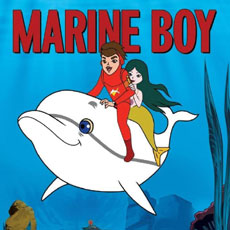Tezuka Productions (1980), Manga Video/Anchor Bay (November 22, 2005), 8 discs, 1530 mins plus supplements, 1.33:1 original full frame ratio, Dolby Digital 2.0, Not Rated, Retail: $39.98
Storyboard:
Astro Boy returned in color for this series that again shows that bravery and compassion can make one more human than actually being made of flesh and blood.
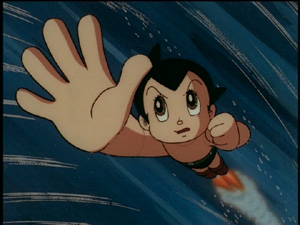
The Sweatbox Review:
Though I always had hoped to see the original Astro Boy on DVD (mission now accomplished, thanks to the recent humungous box sets), the version I grew up with was the 1980 one. It is this version that I can remember fondly, though to be honest it was not truly an absolute favorite of mine. There was, however, something cool about a Japanese show that theorized a time when robots would become sentient and take their place in human society as equals, while still facing difficulties as they try to assimilate into society. Even today, that is a pretty solid sci-fi concept. And now we can look at it again, thanks to an 8-disc set from Anchor Bay and Manga Video.
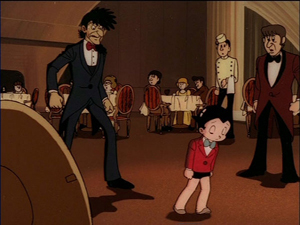
The premise is much the same as the classic comic strip and the 1963 TV show, with only the English names being changed this time around. It is still Dr. Boynton (sometimes said or spelled Boyton) who creates Astro Boy, but this time it is a son named Toby (not Astor) who is killed in a traffic accident in the year 2030— as opposed to 2003 in the manga and first cartoon series. (“Toby” is certainly a better translation of the comic’s “Tobio”.) And once again, Boynton madly thinks of the new robot more-or-less as his flesh-and-blood son, his madness only lifting later on when he realizes that the robot is not behaving like a normal boy. He chases the robot away, and the young robot joins a robot circus (differing slightly from the original show’s version of events, where Boynton sold the robot to the circus; perhaps this seemed too cruel in 1980). The boy robot is discovered there by the new director of the Institute of Science, Dr. Elefun. Elefun becomes a surrogate father to the robot, now named Astro Boy. The origin takes place over the first couple of episodes, and soon Astro is enrolled in school, where he initially faces prejudice from the human kids.
(The theme of prejudice is a strong one in the series, and is part of practically every episode. I must confess that I find it hard to swallow that robots should ever be treated as human equals, and often find myself sympathizing with those characters that rail against the notion, but I can accept it for the metaphor it is. The positive message of understanding and acceptance is what’s important.)
Astro’s teacher also plays a prominent role in the show, re-nicknamed Daddy Walrus rather than Mr. Pompous. Daddy Walrus (real name Albert Duncan) is more than a teacher, as he often accompanies Astro and often fills the role as private eye or secret agent. This is another distinction from the original series, as Daddy Walrus is more courageous than Mr. Pompous. In contrast, Dr. Elefun becomes just a bit more foolish in the 1980 Astro Boy.

Like the earlier show, Astro also gets a robot family, with his mischievous sister Astrogirl being named Uran for this series. Atlas is a continuing nemesis for Astro Boy, being the first “evil robot”, and seemingly giving humanity a reason to fear robots. Atlas, like all great villains, does have an understandable motivation: he wants revenge against humanity for their treatment of robots. He also has the distinction of being a “brother” of sorts to Astro, as is explained during the course of the show, further linking the two. Atlas shares living space in the Crystal Castle with the lovely Livian, who is not nearly so bitter with humans and is more likely to help Astro Boy.
Another recurring character in this version is Skunk, a green-skinned lowlife who constantly seems to get into Astro’s synthetic hair. Skunk’s greatest skill is probably his sense of opportunism, and he often teams up with or manipulates Astro’s other opponents (chiefly robots that Skunk deceives into helping him). Inspector Gumshoe is not a villain, but he is often an adversary, since he often jumps to the conclusion that Astro Boy is guilty while investigating a crime.
Throughout the series, Astro comes into conflict with a variety of robots and scheming humans. His adventures take him around the world, through space, and on one occasion through the time barrier. With powers of rocket-powered flight, super senses, great strength, finger lasers, and butt-deployed guns(!), Astro fights only when he has to, but he fights very well. Despite being exposed to the worst that humanity has to offer, Astro remains naïve and innocent, always attempting to bring opposing sides together.
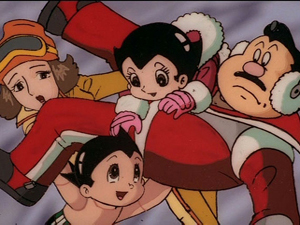
Although Astro’s creator Osamu Tezuka was heavily involved in the original show, the 1980 version carries an even stronger sense of his vision. As the liner notes state in the DVD set’s booklet, Tezuka took full command of the 1980 show and ensured that it captured the essence of his comics. It seemed that over time, Mr. Tezuka developed an even stronger sense of love, justice and a desire for peace. The Astro Boy of this version is more dedicated to peaceful solutions, and is continuously faced with confusion over humanity’s ability to harm itself. Still, he remains dedicated, like Pinocchio, to becoming more human himself. And, like Superman, he can still kick butt when he needs to.
The flip side of this show is its sometimes somber tone. Optimism and lightheartedness is balanced with harsh realities, including how robots are affected by bigotry. While still a positive show overall, there is occasionally a melancholy tone related to the sadness of prejudice. Human villains are liable to suffer as well, but it is often a robot who has been misdirected by a human that suffers the most, resulting in a number of sad endings.
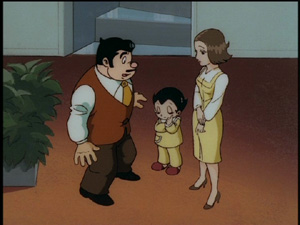
Aside from that, however, there are many adventures here to entertain those that enjoy tales of robots, space travel, time travel, lost civilizations, and the like. Astro Boy is in many ways a typical boys’ adventure series, with a robotic twist. Better yet, the animation of the 1980 Astro Boy leaves its predecessor in the dust, having much more movement and much more detailed backgrounds; but it is still typically stilted anime thanks to its TV budget. It is great to see Astro in color, though, even if the artists did a weak job of designing the color palette for the show. The colors tend to be overly literal, making for an unfortunately drab presentation at times.
The entire 51-episode English language version of the show comes on eight DVDs. There is one episode missing from the Japanese 52-episode run, that being the second one, which introduced Atlas. I do not know why this was missing, as it apparently showed up on the Australian set (on an Extras disc), but I do wish that at least the Japanese version could have found its way onto one of these DVDs. Despite this omission, the episodes are otherwise presented in the Japanese broadcast order, which is quite different than the US airdate order but does make more sense. Also, the credits and titles are all in Japanese (with subtitles available); I cannot recall if it was aired this way in North America.
Incidentally, it is always fun to catch glimpses of Japanese culture in cartoons and cinema. I was surprised to see a Christmas-themed episode on this set, Light Ray Robot, and smiled at the spelling of “Mary Christmas”!
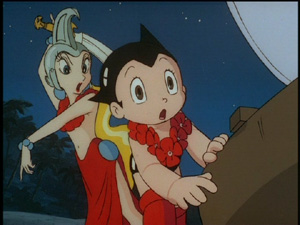
Is This Thing Loaded?
This set comes with a smattering on extras, the type of selection that makes for some nice bullets on the box but actually takes little time to get through. The best is the section devoted to Deleted Scenes (6:55); these are from seven different episodes, presented in Japanese with English subtitles. Highlights include a brief flashback to the creation of Atlas (nice, since we don’t actually get his origin episode), and an on-camera introduction with Osamu Tezuka himself (from Astro’s First Love)!! A scene from Uran’s Twin was obviously removed from the English version due to the inclusion of an original song sung in Japanese.
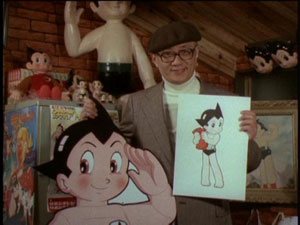
A Restoration Comparison (2:01) comes from the episode Frankenstein. While there is some improvement seen with the restoration, the biggest change seemed to be with a darkening of the colors. Storyboards Of Opening Sequence (1:15) are presented via split-screen with the final product. Original Character Art Gallery (7:08) features model sheets for many of the show’s characters. Original “Astro Boy” Manga Covers (4:59) pretty much shows the same art seen in the set’s booklet. Finally, there are thirteen Character Profiles that offer only the most rudimentary information.
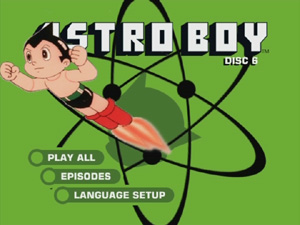
Case Study:
The eight discs are contained in four double-slims. Each slimcase has the same image of Astro Boy as the outer slipcase, in different colors. The rear covers have what could pass for lovely mini-posters of Astro in action. The episode synopses are on the inside of the double-slims, being clear and fairly readable through the plastic. Also included is a spiffy 24-page booklet that has information about Astro Boy and especially Tezuka, as well as lots more color artwork, including comparisons of the English and Japanese episode orders, and Astro’s first appearance from the Captain Atom manga. All in all, it’s a pretty nice package.
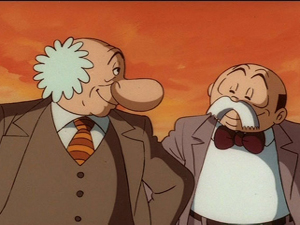
Ink And Paint:
The episodes look pretty good. There is an acceptable amount of light grain and dust that is not too distracting for the most part. Compression artifacts are absent as far as I could see. It is likely that the DVDs look better than what I saw on television in the 1980s, so I’m satisfied. The episodes are naturally presented in their original 4:3 aspect ratio.
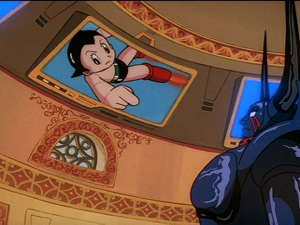
Scratch Tracks:
Well, this was a nice surprise! Aside from the English dub promised on the box, this set also has the Japanese language tracks! Both tracks are in Dolby Digital 2.0, and both are, well, fine. There is not much range to them, and no low end to speak of, but they do fine for what they are to convey the dialog and the disco-inspired soundtrack.
The dubbing on this version of the show is much better than that on the original 1960s series, largely due to the scripters of the dub doing a better job of matching words for length, and thereby avoiding the rushed dialog in the old show. It’s still not a great dubbing job, though, as the unnatural deliveries sound more like amiable recitation.
I noticed at least one instant where the English language version had only the music for a song, while the Japanese version carried the actual lyrics as well. These lyrics are available in the English subtitles in the episode Uran the Tomboy.
Additionally, it may be noted that the subtitles use the original Japanese names for the most part. Dr. Elefun is Dr. Ochanomizu, and Daddy Walrus becomes Daddy Mustache in the subs. Astro stays Astro though, not reverting to his true name of Tetsuwan Atom. There is another English subtitle track that simply offers translation of on-screen Japanese words, and plays by default along with the English audio track.
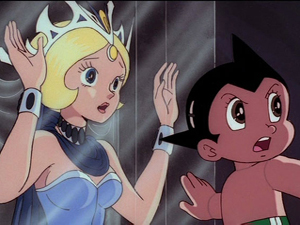
Final Cut:
Returning to it now, I found that the 1980 Astro Boy is still not a big favorite of mine; but I did enjoy seeing the show again, even if I found myself more enamored by the concepts than the execution. The show has a neat premise, certainly, but the animation is not particularly memorable, and the colors seem drab compared to other shows. Astro Boy himself is more “nice” than interesting, not having much of an “edge” to capture one’s interest. Instead, the “edge” of the show comes in its often dour tone, as it explores the disappointment that Astro has for his makers.
Not every episode is a bummer, though, and there are plenty of flights of fancy to be found in the 51 episodes, which should appeal to any lover of science fiction or fantasy. It’s too bad that one episode of the run is missing, but the video and audio presentation are quite good, and there is a decent if modest assortment of extras. Astro Boy remains a television classic, in both its 1963 and 1980 versions, and this set is a great way to find out why.
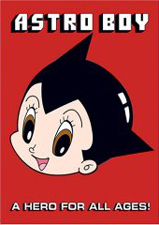 | ||
 |









